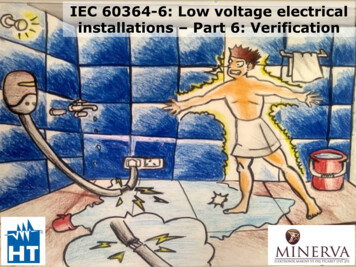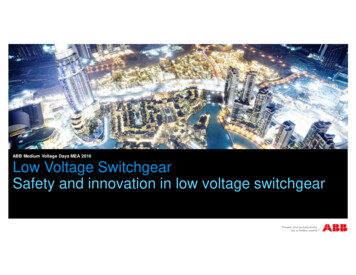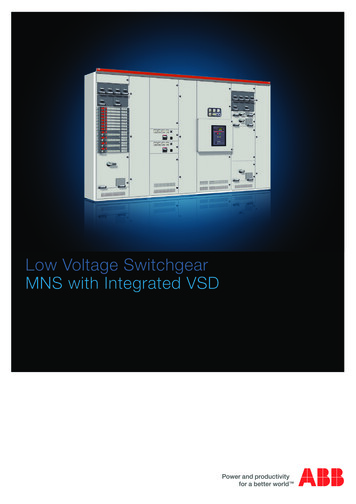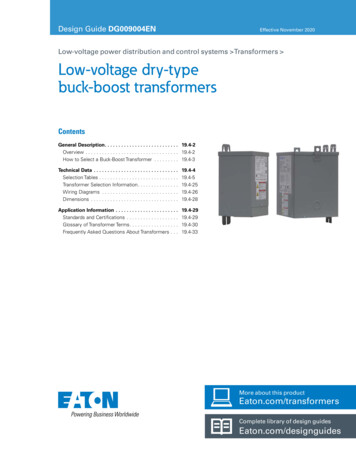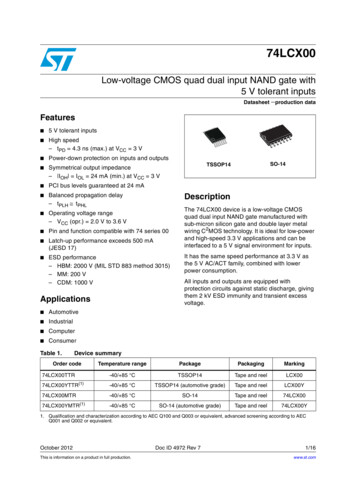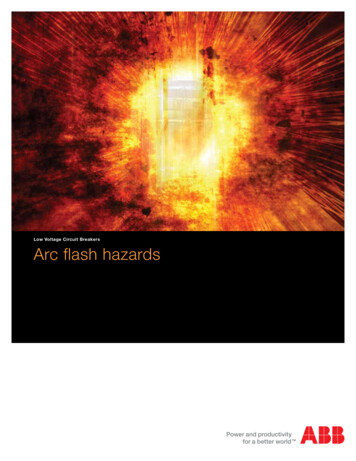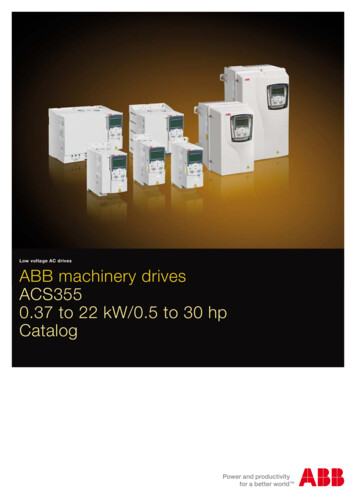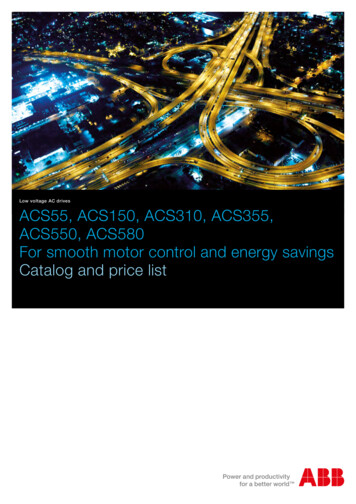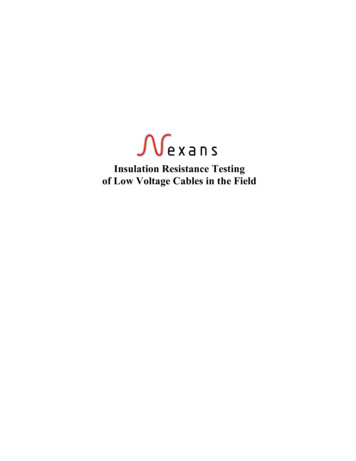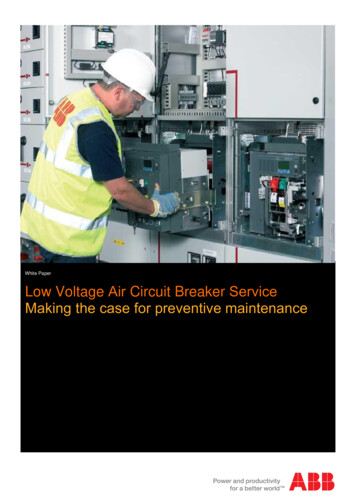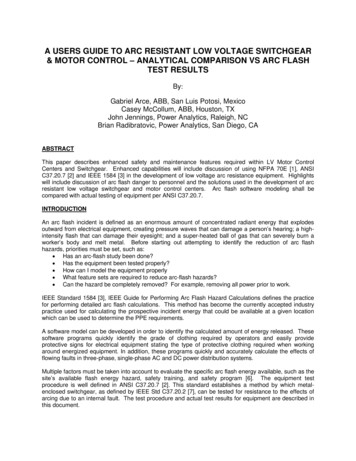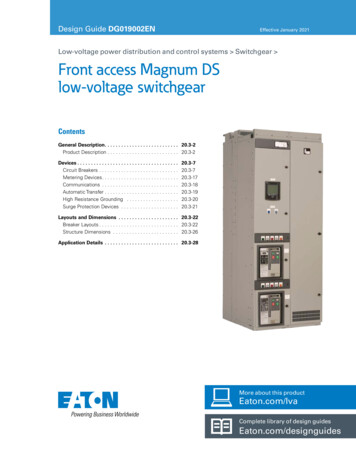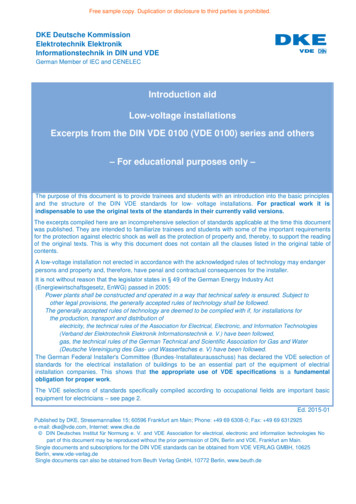
Transcription
Free sample copy. Duplication or disclosure to third parties is prohibited.DKE Deutsche KommissionElektrotechnik ElektronikInformationstechnik in DIN und VDEGerman Member of IEC and CENELECIntroduction aidLow-voltage installationsExcerpts from the DIN VDE 0100 (VDE 0100) series and others– For educational purposes only –The purpose of this document is to provide trainees and students with an introduction into the basic principlesand the structure of the DIN VDE standards for low- voltage installations. For practical work it isindispensable to use the original texts of the standards in their currently valid versions.The excerpts compiled here are an incomprehensive selection of standards applicable at the time this documentwas published. They are intended to familiarize trainees and students with some of the important requirementsfor the protection against electric shock as well as the protection of property and, thereby, to support the readingof the original texts. This is why this document does not contain all the clauses listed in the original table ofcontents.A low-voltage installation not erected in accordance with the acknowledged rules of technology may endangerpersons and property and, therefore, have penal and contractual consequences for the installer.It is not without reason that the legislator states in § 49 of the German Energy Industry Act(Energiewirtschaftsgesetz, EnWG) passed in 2005:Power plants shall be constructed and operated in a way that technical safety is ensured. Subject toother legal provisions, the generally accepted rules of technology shall be followed.The generally accepted rules of technology are deemed to be complied with if, for installations forthe production, transport and distribution ofelectricity, the technical rules of the Association for Electrical, Electronic, and Information Technologies(Verband der Elektrotechnik Elektronik Informationstechnik e. V.) have been followed,gas, the technical rules of the German Technical and Scientific Association for Gas and Water(Deutsche Vereinigung des Gas- und Wasserfaches e. V) have been followed.The German Federal Installer's Committee (Bundes-Installateurausschuss) has declared the VDE selection ofstandards for the electrical installation of buildings to be an essential part of the equipment of electrialinstallation companies. This shows that the appropriate use of VDE specifications is a fundamentalobligation for proper work.The VDE selections of standards specifically compiled according to occupational fields are important basicequipment for electricians – see page 2.Ed. 2015-01Published by DKE, Stresemannallee 15; 60596 Frankfurt am Main; Phone: 49 69 6308-0; Fax: 49 69 6312925e-mail: dke@vde.com, Internet: www.dke.de DIN Deutsches Institut für Normung e. V. and VDE Association for electrical, electronic and information technologies Nopart of this document may be reproduced without the prior permission of DIN, Berlin and VDE, Frankfurt am Main.Single documents and subscriptions for the DIN VDE standards can be obtained from VDE VERLAG GMBH, 10625Berlin, www.vde-verlag.deSingle documents can also be obtained from Beuth Verlag GmbH, 10772 Berlin, www.beuth.de
Free sample copy. Duplication or disclosure to third parties is prohibited.– For educational purposes only – Introduction aid “Low-voltageinstallations” Ed. 2015-01Depending on the field of activity the following selections are the basic equipment for electricians:– VDE selection of standards for electrical engineering in the construction industry,– VDE selection of standards for the electrical installation of buildings,– VDE selection of standards for the power supply company (EVU),– VDE selection of standards for the electrical engineering industry,– VDE selection of standards for the protection in areas potentially endangered by explosivematerial– VDE selection of standards for specialists in information technology,– VDE selection of standards on electrical installations and equipment (selection pursuant toDGUV Vorschrift 3),– VDE selection of standards on functional safety,– VDE selection of standards for medical equipmentThese selections are available from VDE VERLAG GmbH, Bismarckstr. 33, 10625 Berlin, Germany, www.vdeverlag.de on paper, DVD or as pdf files for download when subscribing to the VDE online publications. It is alsopossible at any time to obtain an up-to-date list of standards included in the VDE selections of standards fromVDE Verlag GmbH.The DVD is the best, most convenient, most efficient and still most reasonably priced way of usingelectrotechnical safety standards: The files are part of a convenient document management system enablingthe user to search within the entire VDE Specifications Code of safety standards.An archive also contains VDEspecifications that have been superseded, whose references have been electronically linked and amendedespecially with respect to DIN VDE 0100 so that equally applicable requirementswill not be overlooked.ForewordThe DIN VDE standards compiled in the VDE selection of standards are safety standards in the field of electricalengineering as are all the DIN standards classified as VDE specifications. They describe the present state of theart at the time of their publication. Their importance is underlined by being referred to in laws and regulations.Thus, all DIN VDE standards are a measure for proper technical behaviour in normal operation. However,application of the DIN VDE standards does not release anyone from the responsibility of their actions.For This reason, this document was prepared by the DKE in close cooperation with trainers working in the fieldof vocational training.Special thanks to:Mr Prof. Dr. Ismail Kasikci, Biberach University of Applied Sciences, Building Services and BuildingClimate Engineering,Mr Christoph Kolz, Elektro Technologie Zentrum Stuttgart,Mr Dieter Piskol, Elektrobildungs- und Technologiezentrum, Dresden,Mr Stefan Schweiker, Centre for vocational training of the Chamber of Trade Kassel,Mr Reinhard Soboll, Bundestechnologiezentrum für Elektro- und Informationstechnik, Oldenburg,Mr Udo Sterkel, Centre for vocational training and technology of the Chamber of Trade Rhein-Main, Frankfurt,Mr Karl-Heinz Twietmeyer, Vocational schools of the administrative district of Osnabrück,Mr Wilfried Wahl, Training and technology centre for electrical engineering and information technology,Lauterbach.The DKE Deutsche Kommission Elektrotechnik Elektronik Informationstechnik im DIN und VDE (GermanCommission for Electrical, Electronic & Information Technologies of DIN and VDE) is the national organizationresponsible for the elaboration of standards and safety specifications covering the areas of electricalengineering, electronics and information technology in Germany. The DKE is a joint organization of DIN GermanInstitute for Standardization (Deutsches Institut für Normung e. V.) and the VDE Association for Electrical,Electronic & Information Technologies and actively represents German interests in the international andEuropean standardization organizations IEC, CENELEC and ETSI.The results of standardization work in the DKE are draft standards developed via the public enquiry procedureinvolving public participation. These draft standards are harmonized to a large extent at the European andinternational levels and included in the DIN standards collection as German DIN Standards and, if they containsafety provisions, also included in the VDE Specifications Code of safety standards as VDE specifications, VDEguidelines or VDE prestandards.Continually updated information about the DKE can be found on the website www.dke.de.Frankfurt am Main, August 2014Page 2
Free sample copy. Duplication or disclosure to third parties is prohibited.– For educational purposes only – Introduction aid “Low-voltageinstallations” Ed. 2015-01ContentsPageIntroduction . 4Fundamental principles, assessment of general characteristics, definitions . 7DIN VDE 0100-100 (VDE 0100-100)Definitions . 23DIN VDE 0100-200 (VDE 0100-200)Protection against electric shock . 47DIN VDE 0100-410 (VDE 0100-410)Effects of current on human beings and livestock . 65DIN IEC/TS 60479-1 (VDE V 0140-479-1)Protection against electric shock – Common aspects for installation and equipment . 69DIN EN 61140 (VDE 0140-1)Protection of cables and cords against overcurrent . 77DIN VDE 0100-430 (VDE 0100-430)Selection and erection of electrical equipment – Common rules . .87DIN VDE 0100-510 (VDE 0100-510)Selection and erection of electrical equipment – Wiring systems. 95DIN VDE 0100-520 (VDE 0100-520)Selection and erection of electrical equipment – Wiring systems –Supplement 2: Protection against overload, Selection of overcurrent protective devices,permissible lengths of cables and cords taking into consideration voltage drop anddisconnection times for protection against electric shock . 101DIN VDE 0100-520 Supplement 2 (VDE 0100-520 Supplement 2)Selection and erection of electrical equipment – Earthing arrangements, protective conductorsand protective bonding conductors . 105DIN VDE 0100-540 (VDE 0100-540)Low-voltage electrical installations – Verification . 117DIN VDE 0100-600 (VDE 0100-600)Low-voltage electrical installations – Requirements for special installations or locations . 127DIN VDE 0100-7xx (VDE 0100-7xx)Low-voltage electrical installations – Requirements for special installations or locations –Locations containing a bath or shower . 129DIN VDE 0100-701 (VDE 0100-701)Structure of the series of standards DIN VDE 0100 (VDE 0100) . Back coverPage 3
Free sample copy. Duplication or disclosure to third parties is prohibited.– For educational purposes only – Introduction aid “Low-voltageinstallations” Ed. 2015-01IntroductionIn the installation rules the originally English abbreviations ELV, PELV and SELV are used, which, according toDIN EN 61140 (VDE 0140-1):2007-03, are defined as follows:3.26extra-low voltage (ELV)any voltage not exceeding the relevant voltage limit specified in IEC 61201Amendment to this introduction aid regarding the voltage limit values at extra-low voltage (ELV):Clauses 6 and 6.1 of IEC 61201:1992-08 read as follows:Voltage limits2Voltage limits given are conservative for contact areas up to 80 cm . Higher limits are given for small contactareas for a. c. up to 100 Hz, but no data are available for higher frequencies or for direct current.Voltage limits for alternating currents are r.m.s. values and for a sinusoidal waveform, other waveforms are forfurther study.Voltage limits for direct currents are ripple -free which is conventionally taken as having an r.m.s ripple contentof not more than 10 %. For example, for a ripple-free direct current system of 120 V, the peak does not exceed137 V.6.1 Limits for the steady stateTable 1 gives limits for steady state for d.c. voltages and a.c. voltages in the frequency range of 15 Hz to 100Hz for environmental situations 1 to 3 and normal and fault conditions. Higher limit values are given for a2contact area of less than 1 cm on a non-accessible part.Table N.1 – Limits for steady-state voltageEnvironmental situation1No fault0VSingle fault0VTwo faults16 V a.c.35 V d.c.2316 V a.c.33 V a.c.35 V d.c.70 V d.c.2)55 V a.c.1)33 V a.c.70 V d.c.41)2)Not applicableNot applicable140 V d.c.2)Special applications1) For a non-accessible part with a contact area less than 1 cm 2 , limits are 66 V and 80 V respectively.2)For charging a battery limits are 75 V and 150 V.In IEC 61201:1992-08, Clause 5 the environmental situation are explained:Environmental situation 1The resistances of the skin and to earth are negligible (e.g. under the conditions ofimmersion);Environmental situation 2 The resistances of the skin and to earth are reduced (e.g. in case of moisture);Environmental situation 3 The resistances of the skin and to earth are not reduced (e.g. dry condition);Environmental situation 4Page 4Special situation (e.g. welding, electroplating). Definition of the situation is theresponsibility of the technical committees.
Free sample copy. Duplication or disclosure to third parties is prohibited.– For educational purposes only – Introduction aid “Low-voltageinstallations” Ed. 2015-013.26.1SELV-System(Safety Extra Low Voltage)an electrical system in which the voltage does not exceed the ELV values:– under normal conditions and– under single fault conditions including earth faults in other circuits3.26.2PELV-System(Protective Extra Low Voltage)an electrical system in which the voltage does not exceed the ELV values:– under normal conditions and– under single fault conditions excluding earth faults in other circuitsCharacteristic feature of the DIN VDE 0100 (VDE 0100
German Member of IEC and CENELEC Introduction aid Low-voltage installations Excerpts from the DIN VDE 0100 (VDE 0100) series and others – For educational purposes only – The purpose of this document is to provide trainees and students with an introduction into the basic principles and the structure of the DIN VDE standards for low- voltage installations. For practical work it is .
